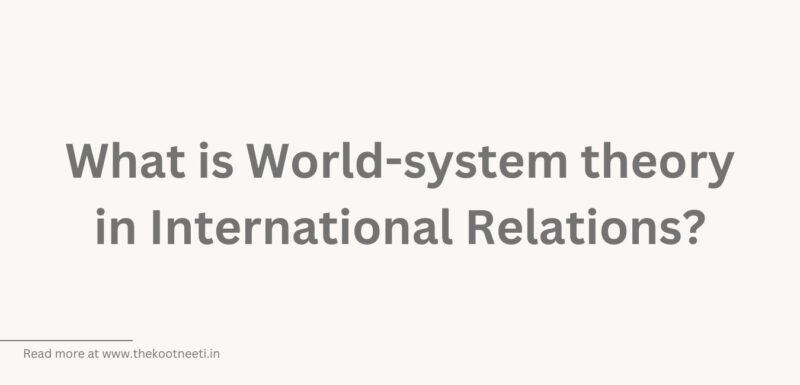What is World-system theory in International Relations?

World-system theory is a perspective in the social sciences that explains how global economic systems operate and how they have changed over time. The theory is primarily associated with the work of sociologist Immanuel Wallerstein and others.
According to world-system theory, the global economy can be understood as a single integrated system, or “world-system,” that is divided into a core, a periphery, and a semi-periphery. The core consists of industrialized, wealthy countries that dominate the global economy and control a disproportionate share of the world’s wealth and resources. The periphery consists of poorer, less industrialized countries that are dependent on the core and often provide raw materials and cheap labor. The semi-periphery is a middle category that includes countries that are not as wealthy or powerful as the core, but are not as poor and marginalized as the periphery.
World-system theory argues that the global economy is shaped by the interaction between these different regions and by the ways in which they are integrated into the world-system. The theory also suggests that the global economy is characterized by inequality and exploitation, with the core countries benefiting at the expense of the periphery and semi-periphery.
World-system theory has been influential in shaping our understanding of global economic systems and has had a major impact on the field of sociology.
World-system theory differs from other theories of globalization in several ways. Some key differences include:
- Historical perspective: Unlike liberal theories of globalization, which tend to focus on the recent period of globalization and view it as a largely positive development, world-system theory takes a longer-term historical perspective and views globalization as a process that has been ongoing for several centuries.
- Structural perspective: World-system theory emphasizes the structural factors that shape the global economy and global politics, such as the power dynamics between core, peripheral, and semi-peripheral states. In contrast, liberal theories of globalization tend to emphasize the role of individual actors and the voluntary exchange of goods and services.
- Emphasis on power and inequality: World-system theory highlights the ways in which globalization has contributed to the concentration of power and wealth in the hands of a small number of states and multinational corporations, and has often resulted in greater inequality between and within countries. Liberal theories of globalization, on the other hand, tend to downplay the role of power and inequality and focus more on the potential for globalization to bring about economic and social benefits for all.
- Explanation of global crises: World-system theory offers a structural explanation for global crises such as financial collapses and wars, which it views as the inevitable result of the ongoing competition between states and the structural inequalities inherent in the global system. In contrast, liberal theories tend to view global crises as isolated events that can be addressed through individual or collective action.
The applications of world-system theory
World-system theory has been applied to the analysis of global politics, economics, and culture in a number of ways. Some examples include:
- Analysis of global economic inequality: World-system theory has been used to understand the patterns of economic inequality that exist between and within countries, and to identify the factors that contribute to these patterns.
- Explanation of the rise and fall of empires: World-system theory has been used to explain the rise and fall of empires throughout history, and to analyze the ways in which different states have sought to maintain or enhance their positions within the global system.
- Analysis of global cultural exchange: World-system theory has been used to understand the ways in which global cultural exchange has taken place, and to identify the ways in which different cultures have been impacted by the global system.
- Explanation of global political dynamics: World-system theory has been used to explain the global political dynamics that shape international relations, including the ways in which states and other actors seek to advance their interests within the global system.
- Analysis of global environmental issues: World-system theory has been used to understand the global environmental issues that are shaping the world today, such as climate change, and to identify the ways in which these issues are connected to the global economic system.


















